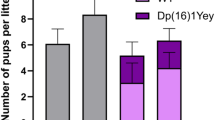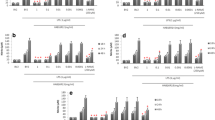Abstract
In regions at risk of scorpion envenomation, children remain the principal victims; they exhibit severe symptoms and represent a higher mortality rate compared to adults. The pathophysiology of envenomation is related to an excessive inflammatory response; however, no studies have identified the differences in immune responses to scorpion stings and mainly the mechanisms of inflammation between children and adults, which may be a determinant key of the susceptibility of children to scorpion envenomation. In this study, we compared the systemic (blood and lung) and the central (brain) inflammatory responses after injection of Androctonus australis hector (Aah) venom to 7 and 21 postnatal days (pnds) and adult mice by subcutaneous route. Results revealed that 7 and 21 pnd mice were more sensitive to Aah venom than adults and presented also severe systemic and central inflammatory responses characterized by a high activation of immune cells, NO liberation, and lipid peroxidation. Lymphocyte levels were much lower in young animals than in adults; however, neutrophil levels seemed to be higher in immature mice. The antioxidant GSH and catalase levels were more reduced in 7 and 21 pnd mice compared to adults leading to more pronounced tissular alterations and edema formation in lung and brain. These findings show a relationship between the severity of the pathophysiological effects of Aah venom and the age. The vulnerability of immature animals to Aah venom might result from uncontrolled inflammatory response and central nervous system alterations. Data from the present study emphasize the need for the development of age-specific therapeutic modalities.








Similar content being viewed by others
References
Adi-Bessalem, Sonia, Djelila Hammoudi-Triki, and Fatima Laraba-Djebari. 2008. Pathophysiological effects of Androctonus australis hector scorpion venom: Tissue damages and inflammatory response. Experimental and Toxicologic Pathology 60 (4–5): 373–380. doi:10.1016/j.etp.2008.03.006.
Adi-Bessalem, Sonia, Amina Mendil, Djelila Hammoudi-Triki, and Fatima Laraba-Djebari. 2012. Lung Immunoreactivity and Airway Inflammation: Their Assessment After Scorpion Envenomation. Inflammation 35 (2): 501–508. doi:10.1007/s10753-011-9338-0.
Adkins, Becky, Claude Leclerc, and Stuart Marshall-Clarke. 2004. Neonatal adaptive immunity comes of age. Nature Reviews Immunology 4 (7): 553–564.
Aebi, Hugo. 1984. [13] Catalase in vitro. In Methods in Enzymology 121–126. Academic Press.
Ait-Lounis, Aouatef, and Laraba-Djebari, Fatima. 2012. TNF-alpha involvement in insulin resistance induced by experimental scorpion envenomation. PLoS Neglected Tropical Diseases 6 (7): e1740. doi:10.1371/journal.pntd.0001740.
Amaral, Carlos Faria Santos, Nilton Alves de Rezende, and Lineu Freire-Maia. 1993. Acute pulmonary edema after Tityus serrulatus scorpion sting in children. The American Journal of Cardiology 71 (2): 242–245. doi:10.1016/0002-9149(93)90746-Y.
Amaral, Carlos Faria Santos, Mariana Borges Dias, Delio Campolina, Fernando Augusto Proietti, and Nilton Alves de Rezende. 1994. Children with adrenergic manifestations of envenomation after Tityus serrulatus scorpion sting are protected from early anaphylactic antivenom reactions. Toxicon 32 (2): 211–215. doi:10.1016/0041-0101(94)90110-4.
Anthony, D.C., S.J. Bolton, S. Fearn, and V.H. Perry. 1997. Age-related effects of interleukin-1 beta on polymorphonuclear neutrophil-dependent increases in blood-brain barrier permeability in rats. Brain 120 (3): 435–444.
Bahloul, M., N. Rekik, I. Chabchoub, A. Chaari, H. Ksibi, H. Kallel, H. Damak, et al. 2005. Neurological complications secondary to severe scorpion envenomation. Medical Science Monitor 11 (4): CR196–CR202.
Björkbacka, Harry, Vidya V. Kunjathoor, Kathryn J. Moore, Stephanie Koehn, Christine M. Ordija, Melinda A. Lee, Terry Means, Kristen Halmen, Andrew D. Luster, and Douglas T. Golenbock. 2004. Reduced atherosclerosis in MyD88-null mice links elevated serum cholesterol levels to activation of innate immunity signaling pathways. Nature Medicine 10 (4): 416–421.
Bonilha, L., F. Cendes, E. Ghizoni, R. Vieira, and L. Li. 2004. EPilepsy due to a destructive brain lesion caused by a scorpion sting. Archives of Neurology 61 (8): 1294–1296. doi:10.1001/archneur.61.8.1294.
Bradley, P.P., D.A. Priebat, R.D. Christensen, and G. Rothstein. 1982. Measurement of cutaneous inflammation: estimation of neutrophil content with an enzyme marker. The Journal of Investigative Dermatology 78 (3): 206–209.
Bucaretchi, Fábio, Emílio C.E. Baracat, Roberto J.N. Nogueira, Aniel Chaves, Flávio A.D. Zambrone, Márcia R.C.C. Fonseca, and Francis S. Tourinho. 1995. A comparative study of severe scorpion envenomation in children caused by Tityus bahiensis and Tityus serrulatus. Revista do Instituto de Medicina Tropical de São Paulo 37: 331–336.
Carvalho, F.F., A.L.A. Nencioni, I. Lebrun, V.A.C. Dorce, and M.R.L. Sandoval. 2000. Convulsive effects of some isolated venom fractions of the Tityus serrulatus scorpion: behavioral, electroencephalographic, and neuropathological aspects. Journal of Venomous Animals and Toxins 6: 238–260.
Cavari, Yuval, Isaac Lazar, Ilan Shelef, and Shaul Sofer. 2013. Lethal Brain Edema, Shock, and Coagulopathy After Scorpion Envenomation. Wilderness & Environmental Medicine 24 (1): 23–27. doi:10.1016/j.wem.2012.09.009.
Chan, P.K., G.P. O’hara, and A. Wallace Hayes. 1982. Principles and methods for acute and subchronic toxicity. Principles and methods of toxicology 12: 17–19.
Chippaux, J.P., and M. Goyffon. 2008. Epidemiology of scorpionism: A global appraisal. Acta Tropica 107 (2): 71–79. doi:10.1016/j.actatropica.2008.05.021.
Claus, C.P., K. Tsuru-Aoyagi, H. Adwanikar, B. Walker, W. Whetstone, and L.J. Noble-Haeusslein. 2010. Age is a determinant of the inflammatory response and loss of cortical volume after traumatic brain injury. Developmental Neuroscience 32: 454–465.
Clot-Faybesse, O., C. Devaux, H. Rochat, and R. Guieu. 2001. In vivo neurotoxicity of Androctonus australis hector scorpion venom: evidence that the supra-thoracic nervous system is not implicated in the clinical manifestations. Toxicon 39 (7): 1003–1007. doi:10.1016/S0041-0101(00)00239-7.
Clot-Faybesse, Olivier, Regis Guieu, Herve Rochat, and Christiane Devaux. 1999. Toxicity during early development of the mouse nervous system of a scorpion neurotoxin active on sodium channels. Life Sciences 66 (3): 185–192.
Cupo, P., M. Jurca, M.M. Azeedo-Marques, J.S. Oliveira, and S.E. Hering. 1994. Severe scorpion envenomation in Brazil. Clinical, laboratory and anatomopathological aspects. Revista do Instituto de Medicina Tropical de São Paulo 36 (1): 67–76.
Finney, DJ. 1978. Statistical method in biological assay Charles Griffin. London, UK.
Folkerts, Gert, Joris Kloek, Richard B.R. Muijsers, and Frans P. Nijkamp. 2001. Reactive nitrogen and oxygen species in airway inflammation. European Journal of Pharmacology 429 (1): 251–262.
Fukuhara, Y.D.M., M.L. Reis, R. Dellalibera-Joviliano, F.Q.C. Cunha, and E.A. Donadi. 2003. Increased plasma levels of IL-1β, IL-6, IL-8, IL-10 and TNF-α in patients moderately or severely envenomed by Tityus serrulatus scorpion sting. Toxicon 41 (1): 49–55. doi:10.1016/S0041-0101(02)00208-8.
Garcia, Annie M., Shaza A. Fadel, Shui Cao, and Marcella Sarzotti. 2000. T cell immunity in neonates. Immunologic Research 22 (2–3): 177–190.
Hatashita, Shizuo, Julian T. Hoff, and Shahriar M. Salamat. 1988. Ischemic brain edema and the osmotic gradient between blood and brain. Journal of Cerebral Blood Flow & Metabolism 8 (4): 552–559.
Kim, Kwang Dong, Jie Zhao, Sogyong Auh, Xuanming Yang, Du Peishuang, Hong Tang, and Fu. Yang-Xin. 2007. Adaptive immune cells temper initial innate responses. Nature Medicine 13 (10): 1248–1252.
Lawson, Linda J., and V. Hugh Perry. 1995. The unique characteristics of inflammatory responses in mouse brain are acquired during postnatal development. European Journal of Neuroscience 7 (7): 1584–1595.
Levy, Ofer. 2007. Innate immunity of the newborn: basic mechanisms and clinical correlates. Nature Reviews Immunology 7 (5): 379–390.
Lourenço, Geane Antiques, Ivo Lebrun, Valquiria A. Coronado, and Dorce. 2002. Neurotoxic effects of fractions isolated from Tityus bahiensis scorpion venom (Perty, 1834). Toxicon 40 (2): 149–157. doi:10.1016/S0041-0101(01)00202-1.
Malih, I, N Oukkache, M Hassar, A El Hilali, N El Gnaoui, H Taki, and H Ben. Etude des effets histopathologiques engendrés par le venin du scorpion marocain «Androctonus mauretanicus mauretanicus» et par sa fraction toxique che z la souris.
Mesquita, Michel B.S., Tasso Moraes-Santos, M. Árcio, and F.D. Moraes. 2003. Centrally injected tityustoxin produces the systemic manifestations observed in severe scorpion poisoning. Toxicology and Applied Pharmacology 187 (1): 58–66. doi:10.1016/S0041-008X(02)00036-4.
Moreno, I., S. Pichardo, A. Jos, L. Gómez-Amores, A. Mate, C.M. Vazquez, and A.M. Cameán. 2005. Antioxidant enzyme activity and lipid peroxidation in liver and kidney of rats exposed to microcystin-LR administered intraperitoneally. Toxicon 45 (4): 395–402. doi:10.1016/j.toxicon.2004.11.001.
Nencioni, Ana Leonor A., Geane Antiques Lourenço, Ivo Lebrun, Jorge Camilo Florio, and Valquiria A.C. Dorce. 2009. Central effects of Tityus serrulatus and Tityus bahiensis scorpion venoms after intraperitoneal injection in rats. Neuroscience Letters 463 (3): 234–238. doi:10.1016/j.neulet.2009.08.006.
Nunan, Elziria A., Márcio F.D. Moraes, Valbert N. Cardoso, and Tasso Moraes-Santos. 2003. Effect of age on body distribution of Tityustoxin from Tityus serrulatus scorpion venom in rats. Life Sciences 73 (3): 319–325. doi:10.1016/S0024-3205(03)00264-9.
Nunan, Elzíria Aguiar, Valbert Nascimento Cardoso, and Tasso Moraes-Santos. 2001. Lethal effect of the scorpion Tityus serrulatus venom: comparative study on adult and weanling rats. Brazilian Journal of Pharmaceutical Sciences 37 (1): 39–44.
Pessini, Andréa C., Danielle R. Santos, Eliane C. Arantes, and Glória E.P. Souza. 2006. Mediators involved in the febrile response induced by Tityus serrulatus scorpion venom in rats. Toxicon 48 (5): 556–566. doi:10.1016/j.toxicon.2006.07.006.
Petricevich, Vera L. 2004. Cytokine and nitric oxide production following severe envenomation. Current Drug Targets-Inflammation & Allergy 3 (3): 325–332.
Petricevich, Vera L. 2010. Scorpion Venom and the Inflammatory Response. Mediators of Inflammation 2010: 16. doi:10.1155/2010/903295.
Potts, Mathew B., Seong-Eun Koh, William D. Whetstone, Breset A. Walker, Tomoko Yoneyama, Catherine P. Claus, Hovhannes M. Manvelyan, and Linda J. Noble-Haeusslein. 2006. Traumatic Injury to the Immature Brain: Inflammation, Oxidative Injury, and Iron-Mediated Damage as Potential Therapeutic Targets. NeuroRx 3 (2): 143–153. doi:10.1016/j.nurx.2006.01.006.
Raouraoua-Boukari, R., S. Sami-Merah, D. Hammoudi-Triki, M.F. Martin-Eauclaire, and F. Laraba-Djebari. 2012. Immunomodulation of the Inflammatory Response Induced by Androctonus australis hector Neurotoxins: Biomarker Interactions. Neuroimmunomodulation 19 (2): 103–110.
Sami-Merah, Sassia, Djelila Hammoudi-Triki, Marie-France Martin-Eauclaire, and Fatima Laraba-Djebari. 2008. Combination of two antibody fragments F(ab′)2/Fab: An alternative for scorpion envenoming treatment. International Immunopharmacology 8 (10): 1386–1394. doi:10.1016/j.intimp.2008.05.011.
Sheldon, R. Ann, Xiangning Jiang, Carla Francisco, Stephan Christen, Zinaida S. Vexler, Martin G. Täuber, and Donna M. Ferriero. 2004. Manipulation of antioxidant pathways in neonatal murine brain. Pediatric Research 56 (4): 656–662.
Sun, Jie, Xueji Zhang, Mark Broderick, and Harry Fein. 2003. Measurement of Nitric Oxide Production in Biological Systems by Using Griess Reaction Assay. Sensors 3 (8): 276.
Van Oosterhout, A.J., I. van Ark, G. Hofman, H.J. Van Der Linde, D. Fattah, and F.P. Nijkamp. 1996. Role of interleukin-5 and substance P in development of airway hyperreactivity to histamine in guinea-pigs. European Respiratory Journal 9 (3): 493.
Zhang, Yuesheng. 2000. Role of glutathione in the accumulation of anticarcinogenic isothiocyanates and their glutathione conjugates by murine hepatoma cells. Carcinogenesis 21 (6): 1175–1182.
Zhao, Jie, Kwang Dong Kim, Xuanming Yang, Sogyong Auh, Fu Yang-Xin, and Hong Tang. 2008. Hyper innate responses in neonates lead to increased morbidity and mortality after infection. Proceedings of the National Academy of Sciences 105 (21): 7528–7533. doi:10.1073/pnas.0800152105.
Zipris, Danny, Egil Lien, Jenny X. Xie, Dale L. Greiner, John P. Mordes, and Aldo A. Rossini. 2005. TLR activation synergizes with Kilham rat virus infection to induce diabetes in BBDR rats. The Journal of Immunology 174 (1): 131–142.
Author information
Authors and Affiliations
Corresponding author
Ethics declarations
Ethics Statement
Animals were used according to the European Community rules of the Ethical Committee for animal Welfare.
Rights and permissions
About this article
Cite this article
Haddad-Ishak-boushaki, W., Laraba-Djebari, F. Age-Related Changes in Inflammatory Response after Experimental Envenomation: Impact on the Susceptibility to Androctonus australis hector Venom. Inflammation 40, 1131–1142 (2017). https://doi.org/10.1007/s10753-017-0557-x
Published:
Issue Date:
DOI: https://doi.org/10.1007/s10753-017-0557-x




